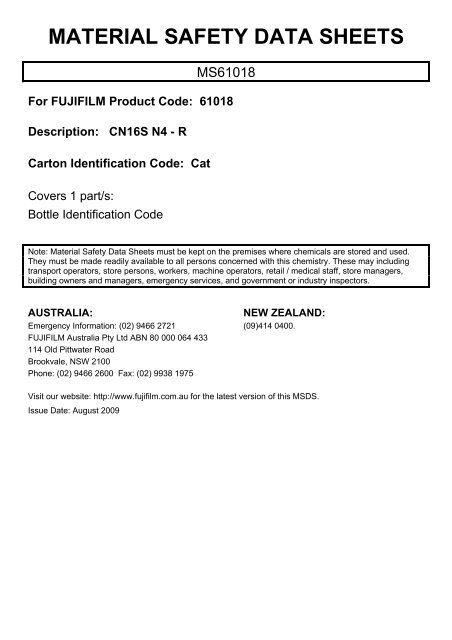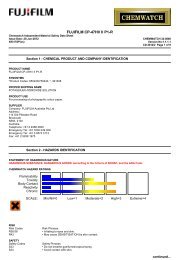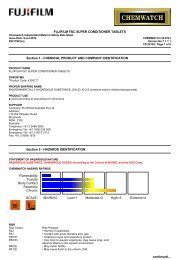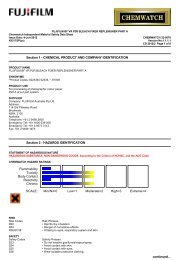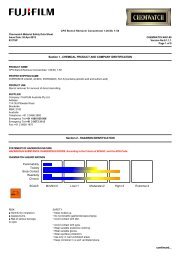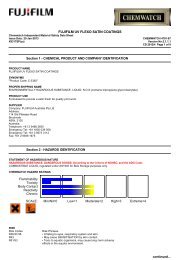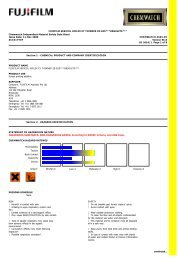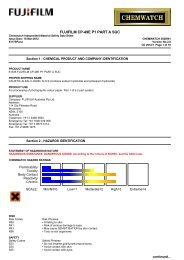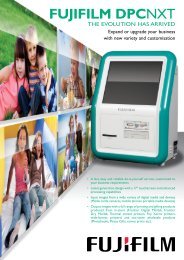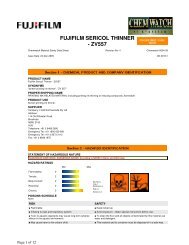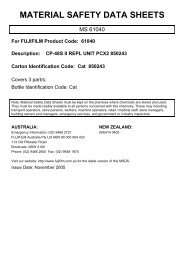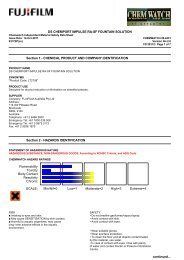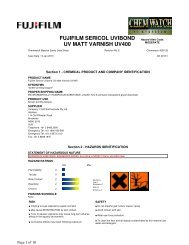CN16S N4 - R - FUJIFILM Australia
CN16S N4 - R - FUJIFILM Australia
CN16S N4 - R - FUJIFILM Australia
Create successful ePaper yourself
Turn your PDF publications into a flip-book with our unique Google optimized e-Paper software.
MATERIAL SAFETY DATA SHEETS<br />
MS61018<br />
For <strong>FUJIFILM</strong> Product Code: 61018<br />
Description: <strong>CN16S</strong> <strong>N4</strong> - R<br />
Carton Identification Code: Cat<br />
Covers 1 part/s:<br />
Bottle Identification Code<br />
Note: Material Safety Data Sheets must be kept on the premises where chemicals are stored and used.<br />
They must be made readily available to all persons concerned with this chemistry. These may including<br />
transport operators, store persons, workers, machine operators, retail / medical staff, store managers,<br />
building owners and managers, emergency services, and government or industry inspectors.<br />
AUSTRALIA:<br />
NEW ZEALAND:<br />
Emergency Information: (02) 9466 2721 (09)414 0400.<br />
<strong>FUJIFILM</strong> <strong>Australia</strong> Pty Ltd ABN 80 000 064 433<br />
114 Old Pittwater Road<br />
Brookvale, NSW 2100<br />
Phone: (02) 9466 2600 Fax: (02) 9938 1975<br />
Visit our website: http://www.fujifilm.com.au for the latest version of this MSDS.<br />
Issue Date: August 2009
Product Name: <strong>CN16S</strong> <strong>N4</strong> - R<br />
This revision issued: July, 2009<br />
Emergency Information: 02 9466 2721 (Aust), (09)414 0400 (NZ)<br />
Page: 1 of 5<br />
SECTION 1 - IDENTIFICATION OF CHEMICAL PRODUCT AND COMPANY<br />
<strong>FUJIFILM</strong> <strong>Australia</strong> Pty Ltd ABN 80 000 064 433<br />
<strong>FUJIFILM</strong> (NZ) Limited<br />
114 Old Pittwater Rd Cnr William Pickering Dr & Bush Rd<br />
Brookvale NSW 2100<br />
Albany, Auckland<br />
Phone: 02 9466 2600 Fax: 02 9938 1975 Phone (09)414 0400<br />
Emergency Information: (02)9466 2721 (Aust), (09)414 0400 (NZ)<br />
Substance:<br />
Water solution of ingredients.<br />
Trade Name:<br />
<strong>CN16S</strong> <strong>N4</strong> - R<br />
Product Code: 61018<br />
Product Use:<br />
Colour stabiliser for colour negative film in mini labs.<br />
Creation Date: August, 2004<br />
This version issued: July, 2009 and is valid for 5 years from this date.<br />
SECTION 2 - HAZARDS IDENTIFICATION<br />
http://www.fujifilm.com.au/<br />
Statement of Hazardous Nature<br />
This product is classified as: Hazardous according to the criteria of SWA <strong>Australia</strong>.<br />
Not a Dangerous Good according to the <strong>Australia</strong>n Dangerous Goods (ADG) Code.<br />
Risk Phrases: R38, R43, R63. Irritating to skin. May cause sensitisation by skin contact. Possible risk of harm to<br />
the unborn child.<br />
Safety Phrases: S28, S24/25. After contact with skin, wash immediately with plenty of soap and water. Avoid<br />
contact with skin and eyes.<br />
SUSDP Classification: None allocated.<br />
ADG Classification: None allocated. Not a Dangerous Good.<br />
UN Number: None allocated<br />
Emergency Overview<br />
Physical Description & colour: Yellow-brown liquid.<br />
Odour: Negligible.<br />
Major Health Hazards: skin irritant, possible skin sensitiser, possible risk of harm to the unborn child.<br />
Potential Health Effects<br />
Inhalation<br />
Short term exposure: Significant inhalation exposure is considered to be unlikely. Available data indicates that this<br />
product is not harmful. In addition product is unlikely to cause any discomfort or irritation.<br />
Long Term exposure: No data for health effects associated with long term inhalation.<br />
Skin Contact:<br />
Short term exposure: Classified as a potential sensitiser by skin contact. Exposure to a skin sensitiser, once<br />
sensitisation has occurred, may manifest itself as skin rash or inflammation, and in some individuals this reaction can<br />
be severe. In addition product is a skin irritant. Symptoms may include itchiness and reddening of contacted skin.<br />
Other symptoms may also become evident, but all should disappear once exposure has ceased.<br />
Long Term exposure: No data for health effects associated with long term skin exposure.<br />
Eye Contact:<br />
Short term exposure: Exposure via eyes is considered to be unlikely. This product may be irritating to eyes, but is<br />
unlikely to cause anything more than mild transient discomfort.<br />
Long Term exposure: No data for health effects associated with long term eye exposure.<br />
Ingestion:<br />
Short term exposure: Significant oral exposure is considered to be unlikely. This product is unlikely to cause any<br />
irritation problems in the short or long term.<br />
Long Term exposure: No data for health effects associated with long term ingestion.<br />
MATERIAL SAFETY DATA SHEET<br />
Issued by: <strong>FUJIFILM</strong> <strong>Australia</strong> Pty Ltd Phone: 02 9466 2600<br />
<strong>FUJIFILM</strong> (NZ) Limited Phone (09)414 0400<br />
Poisons Information Centre: 13 1126 from anywhere in <strong>Australia</strong>, (0800 764 766 in New Zealand)
Carcinogen Status:<br />
SWA: No significant ingredient is classified as carcinogenic by SWA.<br />
NTP: No significant ingredient is classified as carcinogenic by NTP.<br />
IARC: No significant ingredient is classified as carcinogenic by IARC.<br />
Product Name: <strong>CN16S</strong> <strong>N4</strong> - R<br />
This revision issued: July, 2009<br />
Emergency Information: 02 9466 2721 (Aust), (09)414 0400 (NZ)<br />
Page: 2 of 5<br />
SECTION 3 - COMPOSITION/INFORMATION ON INGREDIENTS<br />
Ingredients CAS No Conc,% TWA (mg/m 3 ) STEL (mg/m 3 )<br />
1,2,4-triazole 288-88-0 5-10 not set not set<br />
triazole derivative 91272-91-2 3-7 not set not set<br />
Other non hazardous ingredients secret 1-10 not set not set<br />
Water 7732-18-5 to 100 not set not set<br />
This is a commercial product whose exact ratio of components may vary slightly. Minor quantities of other non<br />
hazardous ingredients are also possible.<br />
The TWA exposure value is the average airborne concentration of a particular substance when calculated over a normal 8 hour working day for a 5<br />
day working week. The STEL (Short Term Exposure Limit) is an exposure value that should not be exceeded for more than 15 minutes and should<br />
not be repeated for more than 4 times per day. There should be at least 60 minutes between successive exposures at the STEL. The term "peak "is<br />
used when the TWA limit, because of the rapid action of the substance, should never be exceeded, even briefly.<br />
SECTION 4 - FIRST AID MEASURES<br />
General Information:<br />
You should call The Poisons Information Centre if you feel that you may have been poisoned, burned or irritated by<br />
this product. The number is 13 1126 from anywhere in <strong>Australia</strong> (0800 764 766 in New Zealand) and is available at all<br />
times. Have this MSDS with you when you call.<br />
Inhalation: First aid is not generally required. If in doubt, contact a Poisons Information Centre or a doctor.<br />
Skin Contact: If poisoning occurs, contact a Poisons Information Centre, or call a doctor at once. Quickly and<br />
gently, blot or brush away excess chemical. Wash gently and thoroughly with water (use non-abrasive soap if<br />
necessary) for 20 minutes or until product is removed. Under running water, remove contaminated clothing, shoes<br />
and leather goods (e.g. watchbands and belts). Completely decontaminate clothing, shoes and leather goods before<br />
reuse or discard. If irritation persists, repeat flushing and obtain medical advice.<br />
Eye Contact: No effects expected. If irritation does occur, flush contaminated eye(s) with lukewarm, gently flowing<br />
water for 5 minutes or until the product is removed. Obtain medical advice if irritation becomes painful or lasts more<br />
than a few minutes.<br />
Ingestion: If product is swallowed or gets in mouth, wash mouth with water and give some water to drink. If<br />
symptoms develop, or if in doubt contact a Poisons Information Centre or a doctor.<br />
SECTION 5 - FIRE FIGHTING MEASURES<br />
Fire and Explosion Hazards: There is no risk of an explosion from this product under normal circumstances if it is<br />
involved in a fire.<br />
Only small quantities of decomposition products are expected from this products at temperatures normally achieved in<br />
a fire. This will only occur after heating to dryness.<br />
Fire decomposition products from this product may be toxic if inhaled. Take appropriate protective measures.<br />
Extinguishing Media: Not Combustible. Use extinguishing media suited to burning materials.<br />
Fire Fighting: If a significant quantity of this product is involved in a fire, call the fire brigade.<br />
Flash point:<br />
Does not burn.<br />
Upper Flammability Limit: Does not burn.<br />
Lower Flammability Limit: Does not burn.<br />
Autoignition temperature: Does not burn.<br />
Flammability Class: Does not burn.<br />
SECTION 6 - ACCIDENTAL RELEASE MEASURES<br />
Accidental release: In the event of a major spill, prevent spillage from entering drains or water courses. Wear full<br />
protective clothing including eye/face protection. All skin areas should be covered. See below under Personal<br />
Protection regarding <strong>Australia</strong>n Standards relating to personal protective equipment. Suitable materials for protective<br />
clothing include rubber, PVC. Eye/face protective equipment should comprise as a minimum, protective goggles. If<br />
MATERIAL SAFETY DATA SHEET<br />
Issued by: <strong>FUJIFILM</strong> <strong>Australia</strong> Pty Ltd Phone: 02 9466 2600<br />
<strong>FUJIFILM</strong> (NZ) Limited Phone (09)414 0400<br />
Poisons Information Centre: 13 1126 from anywhere in <strong>Australia</strong>, (0800 764 766 in New Zealand)
Product Name: <strong>CN16S</strong> <strong>N4</strong> - R<br />
This revision issued: July, 2009<br />
Emergency Information: 02 9466 2721 (Aust), (09)414 0400 (NZ)<br />
Page: 3 of 5<br />
there is a significant chance that vapours or mists are likely to build up in the cleanup area, we recommend that you<br />
use a respirator. Usually, no respirator is necessary when using this product. However, if you have any doubts consult<br />
the <strong>Australia</strong>n Standard mentioned below (section 8).<br />
Stop leak if safe to do so, and contain spill. Absorb onto sand, vermiculite or other suitable absorbent material. If spill<br />
is too large or if absorbent material is not available, try to create a dike to stop material spreading or going into drains<br />
or waterways. Sweep up and shovel or collect recoverable product into labelled containers for recycling or salvage,<br />
and dispose of promptly. Recycle containers wherever possible after careful cleaning. After spills, wash area<br />
preventing runoff from entering drains. If a significant quantity of material enters drains, advise emergency services.<br />
This material may be suitable for approved landfill. Ensure legality of disposal by consulting regulations prior to<br />
disposal. Thoroughly launder protective clothing before storage or re-use. Advise laundry of nature of contamination<br />
when sending contaminated clothing to laundry.<br />
SECTION 7 - HANDLING AND STORAGE<br />
Handling: Keep exposure to this product to a minimum, and minimise the quantities kept in work areas. Check<br />
Section 8 of this MSDS for details of personal protective measures, and make sure that those measures are followed.<br />
The measures detailed below under "Storage" should be followed during handling in order to minimise risks to<br />
persons using the product in the workplace. Also, avoid contact or contamination of product with incompatible<br />
materials listed in Section 10.<br />
Storage: Protect this product from light. Store in the closed original container in a dry, cool, well-ventilated area out<br />
of direct sunlight. Make sure that the product does not come into contact with substances listed under "Materials to<br />
avoid" in Section 10. Some liquid preparations settle or separate on standing and may require stirring before use.<br />
Check packaging - there may be further storage instructions on the label.<br />
SECTION 8 - EXPOSURE CONTROLS AND PERSONAL PROTECTION<br />
The following <strong>Australia</strong>n Standards will provide general advice regarding safety clothing and equipment:<br />
Respiratory equipment: AS/NZS 1715, Protective Gloves: AS 2161, Industrial Clothing: AS2919, Industrial Eye<br />
Protection: AS1336 and AS/NZS 1337, Occupational Protective Footwear: AS/NZS2210.<br />
SWA Exposure Limits TWA (mg/m 3 ) STEL (mg/m 3 )<br />
Exposure limits have not been established by SWA for any of the known significant ingredients in this product.<br />
No special equipment is usually needed when occasionally handling small quantities. The following instructions are<br />
for bulk handling or where regular exposure in an occupational setting occurs without proper containment systems.<br />
Ventilation: No special ventilation requirements are normally necessary for this product. However make sure that<br />
the work environment remains clean and that vapours and mists are minimised.<br />
Eye Protection: Eye protection such as protective glasses or goggles is recommended when this product is being<br />
used.<br />
Skin Protection: If you believe you may have a sensitisation to this product or any of its declared ingredients, you<br />
should prevent skin contact by wearing impervious gloves, clothes and, preferably, apron. Make sure that all skin<br />
areas are covered. See below for suitable material types.<br />
Protective Material Types: We suggest that protective clothing be made from the following materials: rubber,<br />
PVC.<br />
Respirator: Usually, no respirator is necessary when using this product. However, if you have any doubts consult<br />
the <strong>Australia</strong>n Standard mentioned above.<br />
Safety deluge showers should be provided near to where this product is being used.<br />
SECTION 9 - PHYSICAL AND CHEMICAL PROPERTIES:<br />
Physical Description & colour: Yellow-brown liquid.<br />
Odour:<br />
Negligible.<br />
Boiling Point:<br />
Approximately 100°C at 100kPa.<br />
Freezing/Melting Point: Approximately 0°C.<br />
Volatiles:<br />
Water component.<br />
Vapour Pressure:<br />
2.37 kPa at 20°C (water vapour pressure).<br />
Vapour Density:<br />
No data.<br />
Specific Gravity: 1.03<br />
Water Solubility:<br />
Completely soluble in water.<br />
pH: 8.2 at 25°C<br />
Volatility:<br />
No data.<br />
MATERIAL SAFETY DATA SHEET<br />
Issued by: <strong>FUJIFILM</strong> <strong>Australia</strong> Pty Ltd Phone: 02 9466 2600<br />
<strong>FUJIFILM</strong> (NZ) Limited Phone (09)414 0400<br />
Poisons Information Centre: 13 1126 from anywhere in <strong>Australia</strong>, (0800 764 766 in New Zealand)
Odour Threshold:<br />
Evaporation Rate:<br />
Coeff Oil/water distribution:<br />
Autoignition temp:<br />
No data.<br />
No data.<br />
No data<br />
Does not burn.<br />
Product Name: <strong>CN16S</strong> <strong>N4</strong> - R<br />
This revision issued: July, 2009<br />
Emergency Information: 02 9466 2721 (Aust), (09)414 0400 (NZ)<br />
Page: 4 of 5<br />
SECTION 10 - STABILITY AND REACTIVITY<br />
Reactivity: This product is unlikely to react or decompose under normal storage conditions. However, if you have<br />
any doubts, contact the supplier for advice on shelf life properties.<br />
Conditions to Avoid: Protect this product from light. Store in the closed original container in a dry, cool, wellventilated<br />
area out of direct sunlight.<br />
Incompatibilities: No particular Incompatibilities.<br />
Fire Decomposition: Only small quantities of decomposition products are expected from this products at<br />
temperatures normally achieved in a fire. This will only occur after heating to dryness. Carbon dioxide, and if<br />
combustion is incomplete, carbon monoxide and smoke. Nitrogen and its compounds, and under some<br />
circumstances, oxides of nitrogen. Occasionally hydrogen cyanide gas. Water. Carbon monoxide poisoning produces<br />
headache, weakness, nausea, dizziness, confusion, dimness of vision, disturbance of judgment, and<br />
unconsciousness followed by coma and death.<br />
Polymerisation: This product will not undergo polymerisation reactions.<br />
SECTION 11 - TOXICOLOGICAL INFORMATION<br />
Local Effects:<br />
Target Organs:<br />
There is no data to hand indicating any particular target organs.<br />
Classification of Hazardous Ingredients<br />
Ingredient<br />
1,2,4-triazole<br />
Risk Phrases<br />
≥5%Conc≤20%: Xn; R63<br />
SECTION 12 - ECOLOGICAL INFORMATION<br />
Insufficient data to be sure of status.<br />
SECTION 13 - DISPOSAL CONSIDERATIONS<br />
Disposal: Containers should be emptied as completely as practical before disposal. If possible, recycle containers<br />
either in-house or send to recycle company. If this is not practical, send to a commercial waste disposal site. This<br />
product should be suitable for landfill. However, check with local Waste Disposal Authority before sending there. Note<br />
that product properties may have been changed in use, significantly altering it's suitability for landfill. Please do NOT<br />
dispose into sewers or waterways. The use of a commercial waste disposal service is recommended for photographic<br />
wastes as they may contain reclaimable silver or other ingredients which are not desirable in waste water streams.<br />
SECTION 14 - TRANSPORT INFORMATION<br />
ADG Code: This product is not classified as a Dangerous Good. No special transport conditions are necessary<br />
unless required by other regulations.<br />
SECTION 15 - REGULATORY INFORMATION<br />
AICS: All of the significant ingredients in this formulation are to be found in the public AICS Database.<br />
Acronyms:<br />
ADG Code<br />
AICS<br />
CAS number<br />
SECTION 16 - OTHER INFORMATION<br />
This MSDS contains only safety-related information. For other data see product literature.<br />
A more recent version of this MSDS might be found at http://www.fujifilm.com.au/<br />
<strong>Australia</strong>n Code for the Transport of Dangerous Goods by Road and Rail, 7th Edition<br />
<strong>Australia</strong>n Inventory of Chemical Substances<br />
Chemical Abstracts Service Registry Number<br />
MATERIAL SAFETY DATA SHEET<br />
Issued by: <strong>FUJIFILM</strong> <strong>Australia</strong> Pty Ltd Phone: 02 9466 2600<br />
<strong>FUJIFILM</strong> (NZ) Limited Phone (09)414 0400<br />
Poisons Information Centre: 13 1126 from anywhere in <strong>Australia</strong>, (0800 764 766 in New Zealand)
Hazchem Number<br />
IARC<br />
SWA<br />
NOS<br />
NTP<br />
R-Phrase<br />
SUSDP<br />
UN Number<br />
Product Name: <strong>CN16S</strong> <strong>N4</strong> - R<br />
This revision issued: July, 2009<br />
Emergency Information: 02 9466 2721 (Aust), (09)414 0400 (NZ)<br />
Page: 5 of 5<br />
Emergency action code of numbers and letters that provide information to emergency<br />
services especially firefighters<br />
International Agency for Research on Cancer<br />
Safe Work <strong>Australia</strong>, formerly ASCC and NOHSC<br />
Not otherwise specified<br />
National Toxicology Program (USA)<br />
Risk Phrase<br />
Standard for the Uniform Scheduling of Drugs & Poisons<br />
United Nations Number<br />
THIS MSDS SUMMARISES OUR BEST KNOWLEDGE OF THE HEALTH AND SAFETY HAZARD INFORMATION OF THE PRODUCT AND<br />
HOW TO SAFELY HANDLE AND USE THE PRODUCT IN THE WORKPLACE. EACH USER MUST REVIEW THIS MSDS IN THE CONTEXT OF<br />
HOW THE PRODUCT WILL BE HANDLED AND USED IN THE WORKPLACE.<br />
IF CLARIFICATION OR FURTHER INFORMATION IS NEEDED TO ENSURE THAT AN APPROPRIATE RISK ASSESSMENT CAN BE MADE,<br />
THE USER SHOULD CONTACT THIS COMPANY SO WE CAN ATTEMPT TO OBTAIN ADDITIONAL INFORMATION FROM OUR SUPPLIERS<br />
OUR RESPONSIBILITY FOR PRODUCTS SOLD IS SUBJECT TO OUR STANDARD TERMS AND CONDITIONS, A COPY OF WHICH IS SENT<br />
TO OUR CUSTOMERS AND IS ALSO AVAILABLE ON REQUEST.<br />
Please read all labels carefully before using product.<br />
This MSDS is prepared in accord with the SWA document “National Code of Practice for the Preparation of<br />
Material Safety Data Sheets” 2nd Edition [NOHSC:2001(2003)]<br />
Copyright © Kilford & Kilford Pty Ltd, July, 2009.<br />
http://www.kilford.com.au/ Phone (02)9251 4532<br />
MATERIAL SAFETY DATA SHEET<br />
Issued by: <strong>FUJIFILM</strong> <strong>Australia</strong> Pty Ltd Phone: 02 9466 2600<br />
<strong>FUJIFILM</strong> (NZ) Limited Phone (09)414 0400<br />
Poisons Information Centre: 13 1126 from anywhere in <strong>Australia</strong>, (0800 764 766 in New Zealand)


